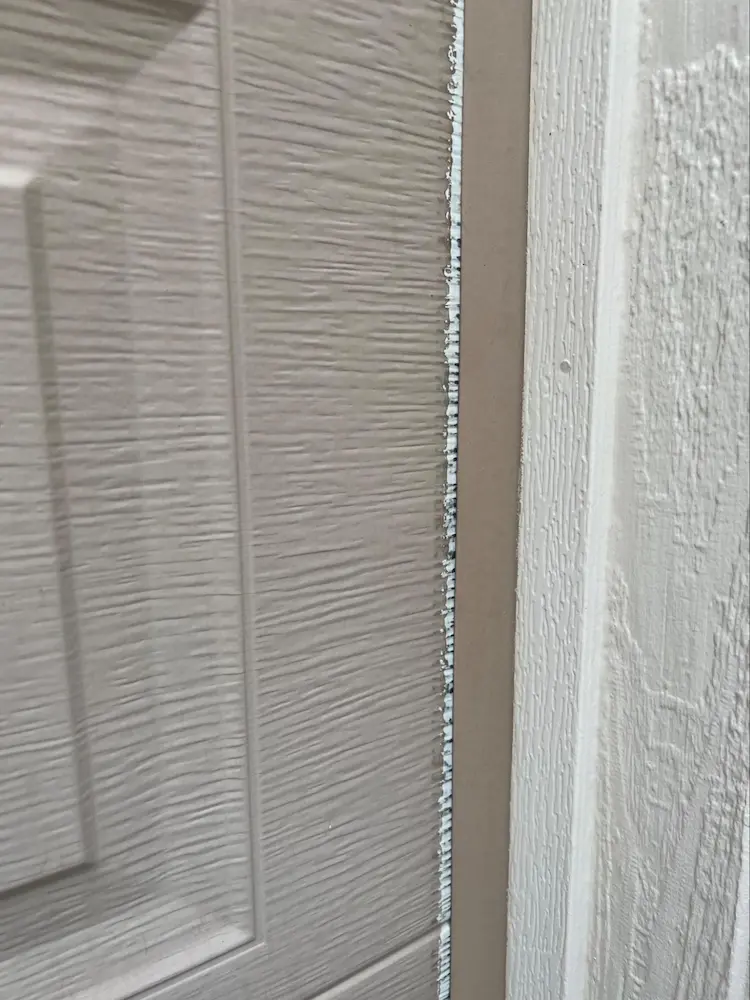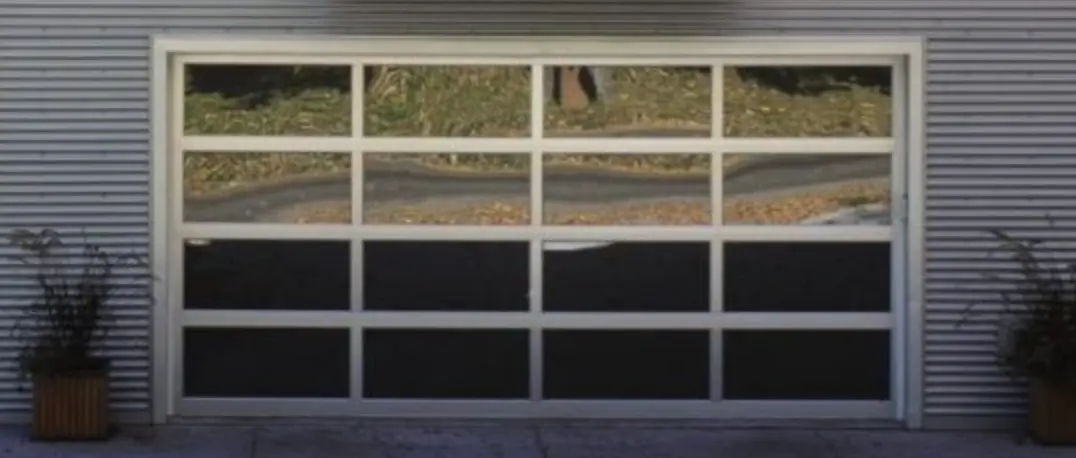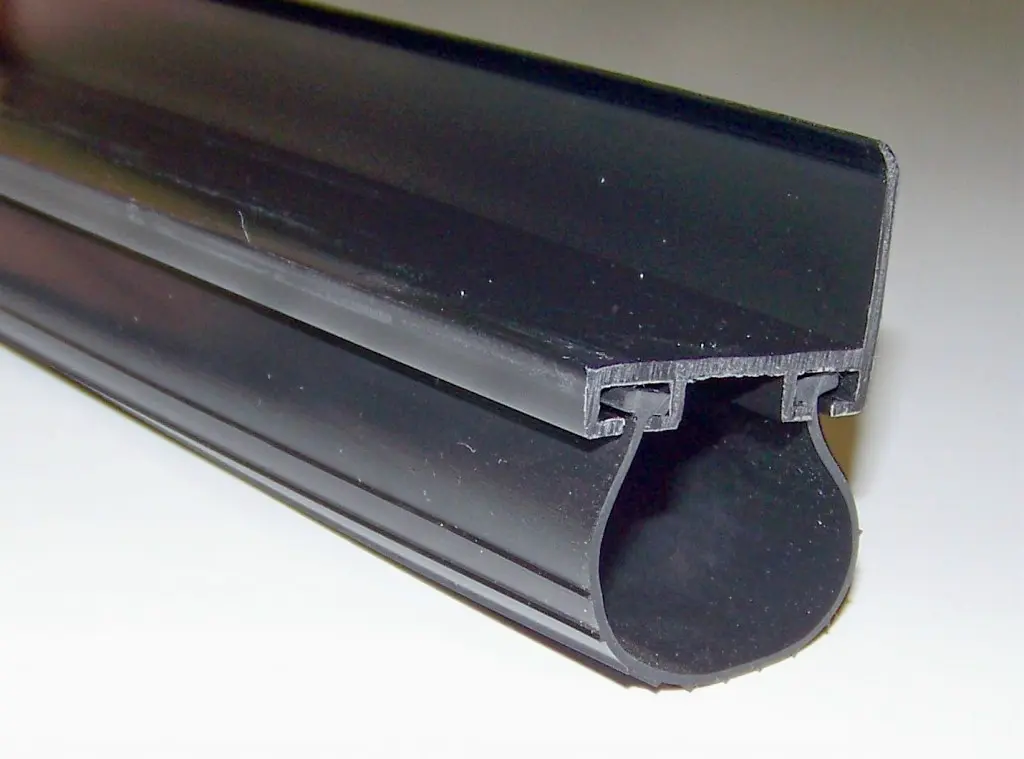Appearance
Garage Doors
Bottom line
No gaps larger than 1/8 inch around any edge, and windows need multiple glass panes with at least one tempered. Motorized lifts must have battery backup. Combustible doors need metal flashing along the bottom six inches to reduce ember exposures.
Overview
Garage doors are typically more vulnerable to ember and radiant heat exposures than exterior doors yet often receive less attention because they are separated from habitable areas or part of a detached garage. When embers are blown into the interior through gaps around the edges of a garage door, they can ignite combustible items commonly stored in garages and destroy a structure. Detached garages are a priority because they are often large structures located less than 50 feet away from a home or other primary structure, which can be ignited through radiant heat exposure from an unmitigated garage.
All gaps around a garage door greater than 1/8 inch must be mitigated with weather stripping or if along the bottom edge gasketing. The bottom edge of the garage door must be in close contact with the landing surface and protected from ember accumulation. All windows must have at least one tempered glass pane to enable it to resist a radiant heat exposure, and tempered glass in both panes of a dual-pane unit are recommended.
Finally, as the primary exit point for most occupants during an evacuation, motorized garage lift units must have a battery backup capable of opening the door and powering the overhead light and in case the grid power is unavailable.
Condition
Garage doors in poor condition do not offer good protection from wildfire exposures and are vulnerable. Common signs of poor condition are significant weathering, dry rot (fungal decay), pieces missing, or large dents that degrade the physical integrity of the door. Mitigation is addressed in Chapter 7A compliance.
Garage door material
Wood
Wood doors will have non-repeating grain patterns, grain patterns that are part of the material itself, and a crisp knocking sound when tapped. Wood doors also feature visible joinery construction with horizontal rails and vertical stile components mated together; this can be more difficult to see if the door is painted but are likely to be present upon closer inspection.
Fiberglass
Fiberglass garage doors are becoming more common and are designed to mimic many types of materials (e.g., wood, metal). Fiberglass garage doors are actually fiberglass-coated steel doors. They can be identified by the horizontal rails and vertical stiles will be a single piece and no joints will be visible other than the horizontal sections that allow them to be lifted on a track. When knocking on the door, it will sound duller than a wood door would, and any grain texture will likely repeat and feel imprinted on the door rather than part of the material itself.
Noncombustible
Steel metal noncombustible garage doors can be identified by magnetic attraction using a handheld magnet. If one is not available, metal doors feel harder when knocked than wood or fiberglass. When opened or closed, they will also typically feel heavier than wood or fiberglass.
 Metal garage door, at the right hand jamb.
Metal garage door, at the right hand jamb.
Aluminum metal noncombustible doors can be identified by the typically narrow rails and stiles and are often combined with glass or acrylic panels for light infiltration.
 Aluminum metal noncombustible garage door. Note thin rails and stiles with transparent panels.
Aluminum metal noncombustible garage door. Note thin rails and stiles with transparent panels.
Unknown
When unable to positively identify the material with high confidence, this is the default material determination.
Perimeter gaps present
If it’s possible to access the interior of the structure, close the door and inspect the perimeter of the door where it meets the door frame/jamb. According to Chapter 7A, California Building Code, section 708A.4. Where gaps larger than 1/8 inch are visible from the interior, embers with ignition potential could penetrate and ignite the structure from the interior. Indicate on which side of the door it is visible; interior left/right means the side of the door when looking at the garage door from the interior.
To mitigate perimeter gaps, install gasketing and/or weather stripping that has been tested to ASTM D628 and ASTM G155 should be installed on the exterior of the vertical sides (i.e., jambs) and top horizontal portion (i.e., header). Alternatively, the jambs and headers can be covered with metal flashing to minimize wind flow into the structure, which can help minimize ember intrusion but will not provide the full energy conservation benefits of weather stripping.
 Interior of a two-car garage with wood doors with gaps larger than 1/8 inch in the upper left corner of both doors.
Interior of a two-car garage with wood doors with gaps larger than 1/8 inch in the upper left corner of both doors.
Bottom gasket present
Garage doors are large and frequently shift based on unintentional collisions, weathering, and ordinary wear and tear, which can cause them not to sit flush with the sill and allow water, air, and/or ember intrusion unless a gasket is present. Gaskets are flexible plastic strips that provide effective sealing from the elements (wind and rain) and, when homes are threatened by wildfire, embers.
To mitigate against ember exposure during a wildfire, observe the presence or absence of a gasket along the bottom edge of the garage door that provides no gaps of more than an 1/8 inch when viewed from the interior. It should be noted that even 1/8 inch gaps are a potential water infiltration hazard and energy inefficient.
 Photo of garage door bottom gasket.
Photo of garage door bottom gasket.
Weather stripping present
None
If no weather stripping is present around the vertical and top horizontal portions of the garage door frame, indicate this option.
Good condition
If weather stripping or metal flashing is present around the vertical and top horizontal portions of the garage door frame and in good condition, indicate this option.
Poor condition
If weather stripping or metal flashing is present around the vertical and top horizontal portions of the door frame but shows signs of delamination or degradation, indicate this option.
Motorized lift unit present
Indicate whether the garage door has a motorized lift unit present. If vehicles regularly enter and exit the garage and there is no motorized lift, consider installing one with a battery backup to reduce precious seconds during an emergency evacuation, especially if the physical effort of opening and closing the garage door are significant.
If no vehicles are regularly parked in the garage and the lift unit is non-functional, then indicate no lift unit present.
When evacuating, it is critically important to close all doors and windows, including garage doors and skylights.
Battery backup present
Indicate whether the motorized lift unit has a battery backup present. To do this, first obtain permission from the property owner or designated contact and check that it is safe to operate (i.e., no obstructions in the path of the garage door as it opens). Then, unplug the lift unit from AC mains power and press the interior lift switch to lift the unit. Observe the lift unit open fully and press the switch again to close it. If the lift does not function on battery power or does not smoothly operate, take a photo of the lift unit and its make/model, if possible (usually indicated on a manufacturer sticker on the back of the unit).
In California, SB 969 requires that motorized lift units installed or replaced since July 1, 2019, have a battery backup. This legislation was enacted because many victims of the 2017 wildfires had lost grid power and were unable to evacuate safely in their vehicles due to their motorized lift openers being disabled.
Vent present
Indicate whether there is a vent in the garage door that provides ventilation of the interior space.
Vent mesh size
Like Attic Vents and Crawl Space Vents, vents in garage doors are vulnerable to ember intrusion, which can ignite combustible materials stored inside. Indicate if the screen mesh size is greater than 1/8 inch or less than or equal to 1/8 inch. If there is no screen, indicate greater than 1/8 inch.
Mitigation options are to install a backing layer of metal mesh with 1/8 inch openings or smaller or to replace the vent with one that meets Chapter 7A requirements.